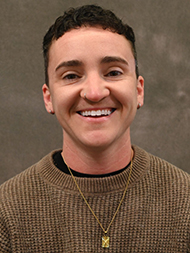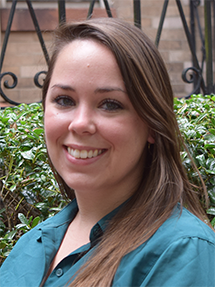Research Weeks 2024 presentations: Social work student researchers and faculty mentors
Five VCU School of Social Work graduate students, two undergraduates and four faculty mentors are part of nine research presentations sponsored by the university as part of Research Weeks 2024.

Graduate Research Symposium
9-11:30 a.m. ET Wednesday, April 24
Student Commons, Commonwealth Ballrooms
Assessing the Impact of Race, Ethnicity and English-Speaking Status on Traffic Stop Outcomes in Virginia
- Presenters: VCUSSW M.S.W. students Lindsay Cunningham and Lilly Hettrick
Background
This study investigates whether traffic stops by police are associated with individual race and ethnicity background or English-speaking status. Recent research indicates both a discrepancy in how often African American and Hispanic individuals experience threats of force compared to their White counterparts and a sizable gap in policing knowledge among non-native English speakers. These findings have the potential to manifest in the coercion and exploitation of non-native speakers by police.
Methods
We will investigate the following research question: Does the likelihood of a police stop differ based on the race, ethnicity, and/or English-speaking status (ESS) of the individual stopped in Virginia? We will use data obtained from the Virginia Community Policing Act Data Collection (VCPADC), publicly available in the Virginia Open Data Portal. The sample includes all 396,740 police stops throughout Virginia in 2022. Three outcomes of police stops are measured: (1) person searches, (2) vehicle searches, and (3) physical force used by officers.
Results
A descriptive analysis indicates that the majority of individuals stopped in 2022 were White (56.5%) or African American (36.1%). Additionally, 54,646 individuals (13.8%) were identified by police as Hispanic or Latino. The researchers will perform further statistical analysis using SPSS software to conduct chi-square tests to test all hypotheses.
Conclusions
This study unveils patterns of traffic stops in Virginia, particularly disparities based on race/ethnicity and ESS. We aim to disseminate our findings to policymakers throughout Virginia to inform policy creation and reform law enforcement practices.
Exploring the Role of Critical Consciousness on Complex Trauma among Adopted Adults
- Presenter: VCUSSW student Rose E. Miola, M.S.W., M.T.S., LCSW

Background
Adopted adults are at high risk of experiencing complex trauma symptoms. A common element of trauma is powerlessness and self blame. Critical consciousness of larger systems of oppression may mitigate individual powerlessness and shame, and inspire purposeful collective action. However there are few empirical studies on the effects of critical consciousness on complex trauma. This study explored the relationship between critical consciousness and complex trauma symptoms among a racially diverse sample of U.S. adult adoptees.
Methods
Data were from a national cross-sectional online survey of 467 adult adoptees. The survey included measures of complex trauma symptoms, stressful life events, and critical consciousness (reflection, motivation, action). Descriptives and hierarchical regression were conducted.
Results
Demographics, age of adoption, adult stressful life events, and critical consciousness subscales explained 29.5% of complex trauma symptoms among participants [R2=.295, (F (12,367)=12.78, p<.001)]. Higher critical motivation predicted lower trauma symptoms (β=-0.15, p<.05); higher critical action predicted higher trauma symptoms (β=.17, p<.001), controlling for other variables.
Conclusions
Results suggest that critical motivation provides adult adoptees a sense of purpose and empowerment, and may support the healing and reduction of trauma, while critical action could lead to more symptoms. Further study of critical consciousness is needed but preliminary findings can inform adoption centers, clinical services, and support groups to consider critical education as a novel way to address trauma in adoptees.
Exploring Factors of Social Well-Being for Non-Binary People
- Presenter: VCUSSW Ph.D. student Kade Goldin, M.S.W., M.Ed.

Introduction
Research focuses significantly on negative outcomes for gender diverse people, which is not always helpful to better understanding well-being.
Studies often combine trans men, trans women, gender diverse individuals, and non-binary people, but these are distinctly different gender identities and need individualized attention.
Exploring factors contributing to social well-being can help inform programs and policies, while also providing helpful feedback to this population.
Objectives
- Explore factors that predict social well-being for non-binary people.
- Examine the relationship between social well-being and mental health for non-binary people.
Methods
- Data Set: TransPop Survey (2021)
- Non-Binary people only, N=76, 0 missing.
- Analyses: Linear Regression
| Variable | Measures |
| Social Well-Being (DV) | Social Well-Being Scale (Keyes, 1998) |
| Demographics | Race, Education, Socioeconomic Status |
| Social Support | The MultidimensionalScale of Perceived Social Support |
| Mental Health | Kessler 6 |
| Non-Affirmation of Gender | Subscale from Gender Minority Stress and Resilience Measure |
| Shared Gender Identity | Survey question: “I feel a part of a community of people who share my gender identity.” |
Sample characteristics
- The sample includes 76 Non-Binary participants, ranging in age from 18-72 years old.
- The participants racial identities are White (68%), Asian (1.3%), Black (6.6%), Hispanic/Latino (5.3%), Middle Eastern (1.3%), Native Hawaiian/Pacific Islander (1.3%), American Indian (1.3%), and Multi-race (14.5%)
- The majority of participants have a High School Diploma and higher education level (81%).
Table 1. Regression Results for Social Well Being (N=76)
B | 95% CI Low High | SE | β | |||
| Education (ref: high school or less) | .273 | -.219 | .765 | .246 | .102 | |
| Race (ref: White) | ||||||
| Latino | -.305 | -.889 | .278 | .292 | -.090 | |
| Other | -.186 | -1.083 | .711 | .449 | -.035 | |
| Black | -.050 | -.793 | .692 | .371 | -.012 | |
| Multi-Race | .229 | -.425 | .883 | .327 | .059 | |
| Socioeconomic Status | ||||||
| (ref: living in poverty) | -.190 | -.645 | .265 | .227 | -.074 | |
| Social Support- Significant Other | .003 | -.133 | .139 | .068 | .005 | |
| Social Support-Family | -.028 | -.142 | .086 | .057 | -.044 | |
| Social Support- Friends* | .185 | .035 | .336 | .075 | .261 | |
| Mental Health*** | -.121 | -.161 | -.081 | .020 | -.601 | |
| Non-affirmation of gender identity* | -.256 | -.484 | -.027 | .114 | -.218 | |
| Shared Gender Identity* | .210 | .026 | .395 | .092 | .200 | |
| (Constant)*** | 4.682 | 3.244 | 6.119 | .719 | ||
| * p<.05, **p<.01, ***p<.001 | ||||||
Results
- This regression model explained 62% of the variance in Social Well-Being for Non-Binary people.
- Social Support from friends was a significant predicator of social well-being (B=.185, p= .035).
- As social well-being increases, we can predict the severity of mental health symptoms will decrease (B= -.121, p=<.001).
- Non-affirmation of one’s gender is less likely to occur when individuals experience higher social well-being (B= -.256, p=.029).
- Being part of a community of people who share one’s gender identity is a significant predictive factor for social well-being (B=.210, p=.026).
Discussion
- It is essential to note how important social support is, specifically from friends.
- Kessler 6 explores mental health, wherein higher scores indicate increased severity of mental health symptoms. Knowing that social well-being is predictive of lower severity in symptoms can provide guidance for non-binary people experiencing mental health challenges and cultivate advocacy for programs that enhance social support.
- Social well-being is linked to less non-affirming experiences, reinforcing the value of asking non-binary people how to affirm their gender identity.
- Findings indicate the importance of non-binary people feeling connected to other non-binary people when it comes to experiencing social well-being.
- A limitation is the relatively small sample and that respondents were predominantly white.
References
Andrews, G., & Slade, T. (2001). Interpreting scores on the Kessler psychological distress scale (K10). Australian and New Zealand journal of public health, 25(6), 494-497.
Keyes, C. L. M. (1998). Social well-being. Social psychology quarterly, 121-140.
Predictors of Suicidality in First-Year College Students: Examining a Five-Factor Impulsivity Model within an Ideation-to-Action Framework
- Presenter: VCUSSW Ph.D. student Samuel Ochinang, LCSW
Authors
Samuel Ochinang, LCSW; Alexis Edwards, Ph.D.; Jacyra Araujo, M.D.; and Karen G. Chartier, Ph.D.

Background
Suicide is the third leading cause of death in the United States for ages 15-24, and the second leading cause of death among college students. Impulsivity is believed to play a role in the progression from suicidal thoughts to suicidal behaviors, and therefore distinguish suicidal ideation from attempts. This study aims to replicate this distinction using an ideation-to-action framework among a diverse sample using a five-factor model of impulsivity.
Methods
Data were drawn from a cross-sectional cohort (N=811) participating in Spit for Science, a longitudinal study of undergraduate students at a large public urban university. Univariate and bivariate statistics were utilized to describe the sample and explore associations between demographic variables and suicidality, depression, and impulsivity. Participants were categorized into three groups (no suicidality, ideation only, and suicide attempt) based on lifetime presence or absence of suicidal ideation and/or attempt. Depression scores were derived from the Symptom Checklist-90, and impulsivity from the UPPS-P scale. Analyses of variance compared group means on impulsivity, and multinomial logistic regression tested predictors of suicidality.
Results
Various dimensions of impulsivity and depression differentiated the ideation-only group and attempters compared to those without suicidality. Conversely, the ideation-only and attempt groups did not differ on study variables. Higher negative urgency and depression scores predicted increased odds of both suicidal ideation and attempt, suggesting a greater prevalence of suicidal thoughts/behaviors among individuals experiencing heightened negative emotions. Increased lack of perseverance was associated with higher odds of reporting no suicidality, consistent with prior research suggesting perseverance is not linked to suicidal ideation or attempts.
Conclusion
Impulsivity is a complex, multidimensional construct. While impulsivity facets did not significantly differentiate between attempters and those with ideation only, cognitive and affective aspects of impulsivity did differ when compared to individuals without suicidal ideation.
Poster Symposium for Undergraduate Research
Thursday, April 25
Student Commons, Commonwealth Ballrooms






Does Ethnic Racial Discrimination and Alcohol Use Predict Anxiety Symptoms in Females
- Presenters: VCUSSW B.S.W. student Paloma Rodriguez Saucedo and VCU students Arlenis Santana, Chelsea Williams, Johanna Pasquel, Maiah Jackson; VCU Spit for Science Working Group; Danielle M. Dick, Ph.D., Rutgers
- VCU GREAT Summer Research Program
- 10:30 a.m.-noon ET
Child Abuse Prevention and Treatment Act: A Black Mother’s Nightmare
- Presenter: VCUSSW B.S.W. student Doryan Slack
- 10:30 a.m.-noon ET
Risk Factors Associated with Developing Substance Abuse Disorders for Adolescents in Second or Last Chance Alternative Schools
- Presenters: VCU student Jaylynn Floyd; VCUSSW faculty Jamie Cage, Ph.D.; VCU faculty Amy Adkins, Ph.D.; VCUSSW faculty Karen Chartier, Ph.D.
- 10:30 a.m.-noon ET
Differences in COVID-19 pandemic drinking alcohol-related consequences between LGBTQ+ and cisgender heterosexual university students
- Presenters: VCU students Jasper Oliver, Namitha Kapa, Michelle Tapia-Lopez, Cole Ward; VCU Spit for Science Working Group; VCUSSW faculty Rebecca Smith, Ph.D.
- 10:30 a.m.-noon ET
Adverse Childhood Experiences and Adolescent Substance Use after the COVID-19 Pandemic
- Presenters: VCUSSW faculty Sunny Shin, Ph.D.; VCU student Casey B. Corso, M.Ed., M.S.
- 1-2:30 p.m. ET